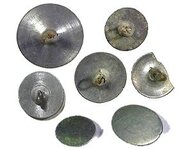PBK
Gold Member
- May 25, 2005
- 6,380
- 271
Yesterday, in another thread, I stated that I believe buttons like the one shown below to be of modern origin, while noting that in the past others have suggested that they are Hessian buttons from the Revolutionary War.
As a result, I have received a number of PM's and e-mails— some questioning my comments, and others supporting them. I hope that the following information will prove interesting and helpful to those who have found such buttons. (Several have previously been posted here on TNet.)
• I can find no evidence that buttons of this design were in use during the Revolutionary War. Despite the fact that they have repeatedly been found, no such button appears either in Don Troiani's book Military Buttons of the American Revolution, or in the definitive earlier work, Calver & Bolton's History Written with Pick and Shovel.
• All of the examples I've seen are two-piece buttons (some with the tinned back rusted out or missing) of a type not in use during the Revolutionary War.
• These buttons are readily obtainable at low prices today— unlike any authentic Revoutionary War buttons that I'm aware of. I found one on eBay, a lot of four for $5 on Ruby Lane, and a set of 11 (four coat, one pocket, six cuff) for $9.99 from another seller. Here are the links:
http://wolfden.ecrater.com/product.php?pid=962249
http://www.rubylane.com/shops/twinkler/item/091025
http://cgi.ebay.com/Estate-sale-find-Copper-button-Teutonic-Eagle_W0QQitemZ160139602908
• Buttons of the same design are still offered, in 25 different finishes, as "fashion buttons" by the Waterbury Button Company. (They are not described as reproductions of historical buttons.)
http://www.waterburybutton.com/user-cgi/patterns.cgi?catg=Fashion&subcatg=Fashion&page=4&id=9837
As a result, I have received a number of PM's and e-mails— some questioning my comments, and others supporting them. I hope that the following information will prove interesting and helpful to those who have found such buttons. (Several have previously been posted here on TNet.)
• I can find no evidence that buttons of this design were in use during the Revolutionary War. Despite the fact that they have repeatedly been found, no such button appears either in Don Troiani's book Military Buttons of the American Revolution, or in the definitive earlier work, Calver & Bolton's History Written with Pick and Shovel.
• All of the examples I've seen are two-piece buttons (some with the tinned back rusted out or missing) of a type not in use during the Revolutionary War.
• These buttons are readily obtainable at low prices today— unlike any authentic Revoutionary War buttons that I'm aware of. I found one on eBay, a lot of four for $5 on Ruby Lane, and a set of 11 (four coat, one pocket, six cuff) for $9.99 from another seller. Here are the links:
http://wolfden.ecrater.com/product.php?pid=962249
http://www.rubylane.com/shops/twinkler/item/091025
http://cgi.ebay.com/Estate-sale-find-Copper-button-Teutonic-Eagle_W0QQitemZ160139602908
• Buttons of the same design are still offered, in 25 different finishes, as "fashion buttons" by the Waterbury Button Company. (They are not described as reproductions of historical buttons.)
http://www.waterburybutton.com/user-cgi/patterns.cgi?catg=Fashion&subcatg=Fashion&page=4&id=9837
As an eBay Associate we earn from qualifying purchases.















